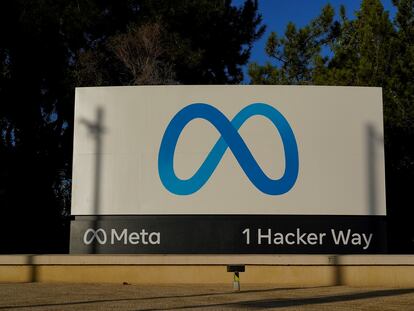Meta announces 10,000 new layoffs and the cancellation of non-priority projects
After laying off 11,000 employees in November, Facebook’s parent company will cut its workforce even further and, in addition, will not fill 5,000 vacancies


Mark Zuckerberg, head of Meta, the parent company of the social networks Facebook and Instagram and the messaging service WhatsApp, shared his roadmap for restructuring the company with workers on Tuesday. It involves a new wave of layoffs: 10,000 in various divisions of the company until the end of the year, plus 5,000 vacancies that will remain unfilled, as well as the cancellation of an unspecified number of “non-priority” projects.
This is the second massive wave of layoffs at Meta, after the 11,000 announced at the beginning of November (13% of its workforce), and also comes in the midst of a banking crisis in the United States, with a potential drag on the technology sector. The announcement had a positive reception on Wall Street, where Meta shares were up 4.77% at the opening of the session.
The objectives of the massive adjustment are, in the words of Zuckerberg, “to make us a better technology company” and “to improve our financial performance in a difficult environment so we can execute our long term vision.” “This will be tough and there’s no way around that,” said the founder and CEO of the technology company.
“Here’s the timeline,” wrote Zuckerberg in the message to the staff published this Tuesday. “Over the next couple of months, org leaders will announce restructuring plans focused on flattening our orgs, canceling lower priority projects, and reducing our hiring rates. With less hiring, I’ve made the difficult decision to further reduce the size of our recruiting team,” the memo detailed. Those affected by the cuts will receive further information this Wednesday.
In the technology divisions, the company expects “to announce restructurings and layoffs in our tech groups in late April, and then our business groups in late May. In a small number of cases, it may take through the end of the year to complete these changes. Our timelines for international teams will also look different, and local leaders will follow up with more details.” In the summer, the company also plans to review its analysis on the hybrid work mode to further adjust costs and efficiency.
In the memo, Zuckerberg acknowledged that the idea of upcoming organizational changes creates uncertainty and stress, in an already worrying economic environment. “My hope is to make these organizational changes as soon as possible in the year so we can get past this period of uncertainty and focus on the critical work ahead,” he wrote.
In early February, Meta reported a net profit of $23.2 billion in 2022, a sharp 41% drop from the result recorded a year earlier. Its annual revenue totaled $116.609 billion, down 1.1% from 2021, the first annual drop in the company’s turnover.
Looking ahead to this year, Meta CFO Susan Li expressed confidence that total revenues for the first quarter will be in the range of $26 billion to $28.5 billion, while total expenses for the full year will be in the range of $89 billion to $95 billion, compared to the previous assessment – prior to the announcement of further layoffs – of $94 billion to $100 billion.
The California-based Menlo Park tech company is not alone in tightening its belt after two boom years fueled by telecommuting and a huge demand for home entertainment during the pandemic. The big technology companies, known as the Big Five, and the titans of Wall Street have undertaken a series of layoffs to try to weather a period of high inflation and Federal Reserve’s tightening of the price of money. The combination of rapid interest rate hikes (eight in a row) and increasingly weak consumer demand have forced companies such as Amazon, Disney, Meta and large banks to cut their workforces. The social network Twitter also announced mass layoffs. In total, tech companies shed more than 150,000 workers in 2022, according to the tracking portal Layoffs.fyi, while more adjustments are expected as economic growth slows.
Sign up for our weekly newsletter to get more English-language news coverage from EL PAÍS USA Edition
Tu suscripción se está usando en otro dispositivo
¿Quieres añadir otro usuario a tu suscripción?
Si continúas leyendo en este dispositivo, no se podrá leer en el otro.
FlechaTu suscripción se está usando en otro dispositivo y solo puedes acceder a EL PAÍS desde un dispositivo a la vez.
Si quieres compartir tu cuenta, cambia tu suscripción a la modalidad Premium, así podrás añadir otro usuario. Cada uno accederá con su propia cuenta de email, lo que os permitirá personalizar vuestra experiencia en EL PAÍS.
¿Tienes una suscripción de empresa? Accede aquí para contratar más cuentas.
En el caso de no saber quién está usando tu cuenta, te recomendamos cambiar tu contraseña aquí.
Si decides continuar compartiendo tu cuenta, este mensaje se mostrará en tu dispositivo y en el de la otra persona que está usando tu cuenta de forma indefinida, afectando a tu experiencia de lectura. Puedes consultar aquí los términos y condiciones de la suscripción digital.
More information
Archived In
Últimas noticias
Daytime, headphones, no booze involved: How a generation is saying ‘no’ to club parties
Millennia-old Yuracaré language resists extinction through 900 speakers and a new dictionary
Susan Boyle prepares a comeback just as Timothée Chalamet sings her praises
Trump suspends green card visa lottery after shooting at Brown University
Most viewed
- Christian Louboutin: ‘Young people don’t want to be like their parents. And if their parents wear sneakers, they’re going to look for something else’
- Cartels in Mexico take a leap forward with narco-drones: ‘It is criminal groups that are leading the innovation race’
- Liset Menéndez de la Prida, neuroscientist: ‘It’s not normal to constantly seek pleasure; it’s important to be bored, to be calm’
- ‘El Limones’ and the growing union disguise of Mexican organized crime
- US sanctions against jailed cartel leader ‘El Marro’ highlight Mexico’s lack of control over its prisons










































